Vintage International Antique Auto Show
Vancouver British Columbia Canada
A Retrospective written by Show Chairman John Carlson in 2020
One of the major events organized for the Expo 86 World Fair was the Vintage International Antique Auto Show held at BC Place Stadium between July 6-10, 1986. The event featured the “Wheels of Time.” According to organizer and Show Chairman John Carlson, the 500-vehicle car show and Concours d’Elegance was a World Exposition first.
In 1980 the British Columbia Government made a request of the Vintage Car Club of Canada (VCCC) National body to stage an event for Transpo 86. Eventually the BC Government changed the name to Expo 86. Carlson, then National President of the VCCC drew up plans for the proposed show. He lobbied his local Vancouver Chapter of the VCCC for support. The chapter agreed and over the next six years, “literally hundreds of hours” were devoted to raising the necessary funds, acquiring sponsorships, making reservations, and obtaining the necessary permits to host the event. Carlson approached both the BC Government and Expo 86 to act as major sponsors. They agreed. The British Columbia Automobile Association asked to become involved and also assumed the role as a major sponsor. Shell Oil Canada assumed the role as the official fuel supplier of the show. This group rounded out the major sponsorship roles.
The Vancouver Chapter of the Vintage Car Club of Canada also made available a significant financial donation with funds raised by a vehicle raffle headed by VCCC member Dick Pardon. None of these funds were used and remained with the Chapter. The entire proceeds from the show were presented to the Vancouver Chapter after the show ended. These funds were to be used to provide a future permanent home for the Vancouver Chapter and the VCCC National body. Each of the various sponsors had a significant presence as the 5-day show opened on July 6th 1986.
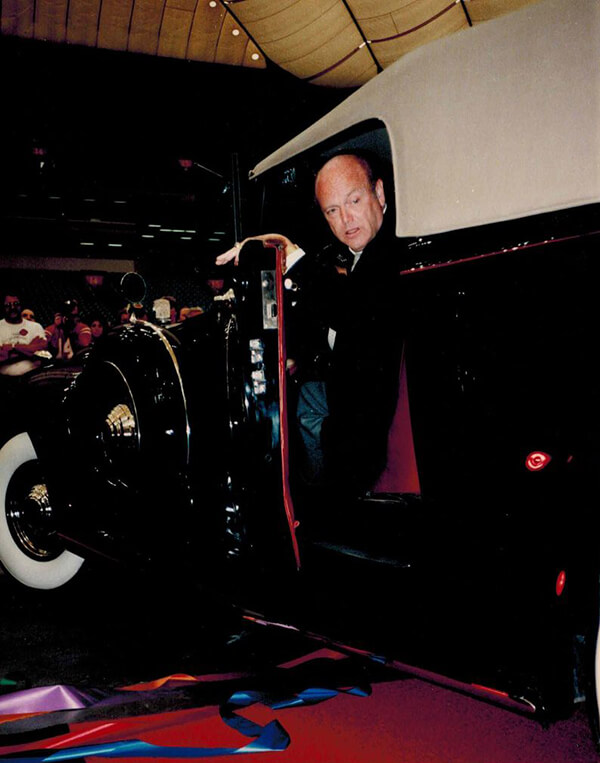
On the morning of July 7, 1986 BCAA President Andrew Makin, BC’s Minister of Tourism Claude Richmond, Shell Oil manger Eric Tegelberg & Shell vice president, western complex Carmine Falcone and show chairman John Carlson were chauffeured down the red carpet in Carlson’s stunning black 1939 Packard V12 Victoria convertible driven by Expo 86 Chairman Jimmy Pattison. Pattison drove the vehicle down the center of the red carpet in BC Place Stadium to the applause of hundreds of spectators and well-wishers.
Mr. Pattison exited the car and did the show opening honors by cutting the twenty foot multi colored grouping of ribbons to open the show. He then skillfully backed the Packard into its resting place.
Expo Chairman Jimmy Pattison played his French horn and Minister of Tourism Claude Richmond joined him with his trumpet. The crowd cheered with excitement. Approximately 500 vehicles were on display during the week-long event. Vehicles had been shipped from around the world to attend. The furthest traveled was a vehicle from Montevideo Uruguay. Many vehicles traveled from across the USA and Canada. The application process was full and closed nearly a year before the show actually opened.
The show was divided into eight “Eras of Time” so that a complete cross-section of vehicles could be viewed beginning with the late 1880s. Once each ‘Era’ timeframe was full that group was closed to ensure there would be equal representation in each of the other grouping of cars. Many ‘world class’ collectors displayed their vehicles including Joe Mitchell owner of Carter GM, Harold and Nancy LeMay from Tacoma WA. Harold held the Guinness world’s record for owing the largest collection of collector cars in the world, brought his highly modified turbine jet powered 1932 Hot Rod Ford roadster accompanied by a stunning 1931 Cadillac All Weather Phaeton. Classic car dealer and restorer Tom Crook traveled from Renton Washington to display his black and silver J2 Duesenberg. Brent McKinley from Arlington WA. also displayed a world class J2 Duesenberg. Classic Car Club of America Larry Justice and wife Lorraine brought a 1934 Packard Phaeton from Seattle. Terry Johnson and his father Allan Johnson from the VCCC brought several cars. Noted Model A Ford restorer Jerome ‘Moose’ Hauck from Summerland BC showed a perfectly restored 1930 Model A roadster. His show booth stantions were four high miniature electrical tower replicas that actually lite up. Dr. Gerald Greenfield, Lake Tapps WA. brought a time warp original unrestored, Preservation Class 1951 Chevrolet that had the distinction of being the most original vehicle in the show.
The winners of the best presented vehicle display were Alan and Helen Shannon, and Eldon and Avis Stafford from Calgary Alberta. Their display depicted a rustic log cabin scene with two Model A Fords parked in front. It was bordered by freshly cut cedar and hemlock trees. Some trees were over 12 feet tall. Rumor has it that the trees came from under the chairlift of a nearby north shore mountain. The Antique Chapter of the VCCC won the best club display with a stunning exhibit of a period working garage with many associated antique garage items including over fifty pre 1916 vehicles. The display was world class.
There were also one hundred custom and modified vehicles on display on the upper walkway floors of the Stadium. Many of the top Hot Rod builders from across North America were in attendance. Legendary pinstriper and ‘Street Rodder magazine’ car cover celebrity Don Audel from Spokane Washington was showing a spectacular Model A Ford for Spokane Washington’s Dan Kroetch.
International Show Association Pacific Northwest Region Chairman Bob Schoonhoven from the USA was in attendance showing two of his highly customized award-winning vehicles. Legendary Vancouver dragster builder Jack Williams displayed his Syndicate Scuderia. This racecar had won the ‘Best Appearing’ vehicle at the summer NHRA Nationals in Pomona Calif. It was displayed with the famous 1929 Ford ISCA/MAFCA National Champion Henry’s Lady owned by Koko & John Carlson. The 25 foot backdrop was titled ‘Canadian Record Setters.’
BC Place Stadium was a very impressive gathering of the world’s best ‘stock’ collector and Hot Rod and custom vehicles.
The operating budget for the event was approximately $265,000 with an additional advertising budget of $750,000 supplied by Shell Oil. Every Shell service station in British Columbia offered a two for one ticket to the show with every fill up. All of the funds to put on the show were raised or donated. No Vintage Car Club of Canada funds were used. Dick Robertson signs supplied all of the signage. The major sponsors included Expo 86 Corporation, the Government of British Columbia, British Columbia Automobile Association (BCAA) and Shell Canada Limited. The event was sanctioned by the National Association of Automobile Clubs of Canada Corporation – www.naacc.ca It was initially expected that a 100,000 people would come through the gates of BC Place to see the exhibit; however, the show broke all attendance records and averaged 40,000 spectators a day. Large crowds viewed the vehicles and enjoyed their wonderful displays. Long spectator lines formed in anticipation of each days viewing. At one point it was estimated that over 1500 people waited as much as 3 hours to gain entry to the Stadium.
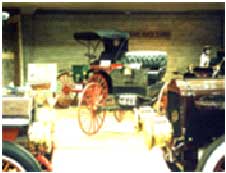
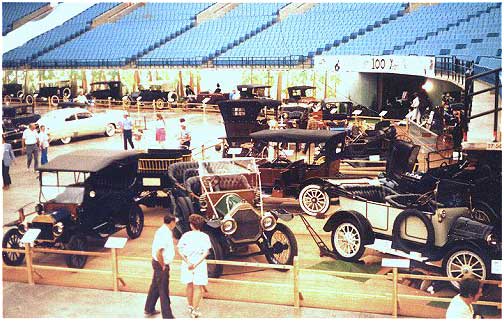

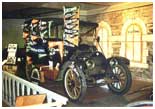
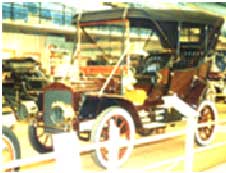
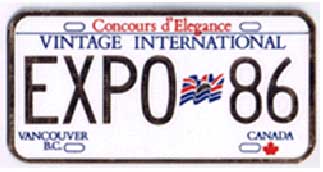
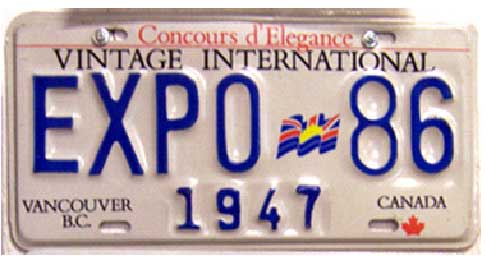
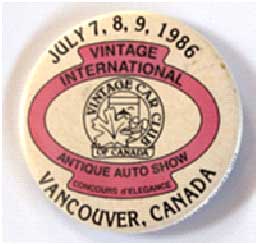
IMAGES COURTESY OF LORNE FINDLEY AND THE VINTAGE CAR CLUB OF CANADA
Souvenirs:
There were many unique souvenir items that were designed by Carlson and presented to dignitaries and participants of the auto show.
A souvenir license plate was issued to each participant and had their registration number proudly displayed on the plate. There were colorful engraved lapel pins designed for each of the committee members. The pins were all the same shape but were colored differently with the committee name engraved in the center of each pin. The pins were colored red for participants, blue for judges, yellow for security, green for hosts, purple for the fashion show and orange for the parade participants. These limited-edition pins instantly became serious collector items and are still sought after 37 years later. Alan Trammell, owner of Pressed Metal Products, Vancouver BC, was commissioned to make and supply the special and highly sought-after pins. They were made of solid brass with different colored borders. ‘striking’ is the only word that can describe them. Each pin was also accompanied by an embossed ribbon of the same color. It was easy to identify each person’s job or function by the color of the pin and ribbon they wore.
A small brass engraved “dash-plaque” that mirrored the larger license plate was also presented to the participants. All participants in the show were also issued an acid etched red bordered 4 ½ inch participant radiator badge, engraved lapel pin and detailed program booklet with each car featured.
Each souvenir license plate displayed the “EXPO 86” logo embossed lettering along with a specific reference to the “Vintage International” Antique Auto Show. Thanks to Superintendent of Motor Vehicles Keith Jackman the plates were made available by the Department of Motor Vehicles. The licence plates were manufactured by Astrographic Industries located in Surrey BC; the same manufacture as the regular BC motorist plate at the time.
These licence plates were not considered legal and could not be used ‘officially’ on BC public highways or roads, however many Expo show plates were displayed on the front of the display cars are still seen on collector vehicles today some thirty plus years later. A small stamped number located bottom center denoted the vehicle registration number and stall number within BC Place Stadium. The plates were stamped with numbers between 1–500.
It has been suggested that the plate featured in this article was a prototype plate. This is not true. There were a wide range of plates made that had the year of the car connected to them. These plates were given as a thank you to owners who had cars that matched the year of the plate. Mr. Dennis Groundwater was the Best of Show Era winner in the Hot Rod Modified Class. He was presented the 1947 Expo license plate along with a 75 lb. brass sculpture wall plaque. After much laughter it took two people to carry it away at the 1000 seat awards banquet held at the Hyatt Regency Hotel in Vancouver. A Souvenir program featuring dignitaries and pictures of the display vehicles was supplied free of charge to each participant. To view the program guidebook, including a listing of the participants by stall number and photos of the cars. simply click the ‘Link’ below. Sorry, it takes about 30 seconds to load.
Download Concours Booklet here >>
The Expo button pictured above was not a sanctioned official button for the event. However, it was widely seen.
License plates that did not have stamped numbers were given out as souvenirs or as a thank you to dignitaries and sponsors. They were not used in the show itself. It has been rumored that there were also cars on display outside of the BC Place Stadium using unnumbered plates. This is not true. There were no show cars on display outside of the stadium.
BC Place Stadium Contract:
It should be noted that that first ‘official contact’ that BC Place Stadium ever had was with the Vintage International Antique Auto Show. In 1981 when Carlson approached the stadium management the Stadium was in the planning stages. BC Place Stadium opened its doors on June 19, 1983. The first contract was written jointly by BC Place Manager Harry Renaud, Dave Forest, then president of the Vancouver Chapter of the Vintage Car Club of Canada and John Carlson. At the same time Carlson and Forest reserved one thousand nearby parking spaces. These spaces were part of the working agreement much to the chagrin of public parking company Impark. Thanks to the BC Government and Expo Chairman Jimmy Pattison the contact was honored and all participants, Vintage Car Club of Canada members and workers parked for free for week in downtown Vancouver. The parking lots were equipped with toilets and showers for those participants who brought motor homes or campers. Security in the parking lot was visible around the clock.
Judging
Carlson designed and implemented the show judging and scoring criteria and developed a strict judging code of ethics. Just three years later in 1989 the National Association of Automobile Clubs of Canada (NAACC) officially adopted this judging system. As of 2023, 37 years later, the judging format is still in use. www.naacc.ca (The NAACC Judging Guidelines have been revised 12 times in the past 37 years )
Long time VCCC members and vehicle restorers Ed Aveling and Bart Nygard acted as co-Chief Judges for the show. VCCC member Peter Trant helped arrange two judging seminars at BCIT and acted as the Master of Ceremonies for the fashion show. Carlson acted as MC for the Opening ceremonies.
The judging system worked on a 1000 point total deduction system, with all cars starting at 1000 points and being judged in specific areas such as electrical, body and paint, upholstery, running gear, exhaust system, chassis, etc. Authenticity and correctness were empathized. Each judging team was selected for their expertise and vast experience in the car hobby. They worked in teams of three. Points were deducted for incorrect parts and poor-quality workmanship. Every vehicle that scored 900 or more points was considered a ‘First Place’ vehicle, and therefore, received an engraved 12-inch sterling silver Concours Award for their achievement. The highest point vehicle of each of the eight Era’s was awarded a Best of Show ‘Era’ Award consisting of large three-foot-long brass wall sculpture manufactured by a Four Way Foundry. It weighed 75 lbs.!
Many key players had significant roles in making the show a success. Some of these people are:
- Koko Carlson was the registration chairperson. She took a year off work forfeiting her teacher’s salary and adding an extra year to her retirement so that she could devote full time to the registration process. She started accepting registrations in 1983. Her computer was an Apple 2 ‘E’ complete with folding 14 inch spread sheets.
- Richard Lancaster did a masterful job in designing and laying out the Stadium showfield via his drawings. His plans for the Stadium vehicle layout were done to exact scale and were flawless.
- Ron Morris was in charge of the move in and the moving out process. He raced around the stadium on his electric scooter for two days. The move in through the giant ‘air locked’ doors went very smoothly thanks to Ron.
- Al Scholes looked after security. He had a crew of well over fifty security guards. They worked in shifts. All wore Expo security brass badging outlined in yellow complete with a yellow ribbon that read Security.
- Peter Trant was the Master of Ceremonies for the Fashion Show that was held for the participants in the evening. Each fashion show official wore an Expo brass badge outlined in purple complete with an embossed purple ribbon.
- Victor Houghton looked after the outside parking duties. His crew worked all day- every day during the show. They managed the 1000 stall parking facility complete with showers and bathroom facilities. Now retired Vancouver policeman John Welch, Wayne Taylor, Earl Tucker, Milton Blewett, Peter Koch, Dick Pardon, Milt Porteous and many other helpers worked long hours to insure all went smoothly.
- Betty Houghton, acted as Fashion Show Coordinator and grandmother to all 😊
- Ivan Sayers was the presenter of the Fashion Show—a truly stunning world class event!
- Alyn Edwards (BCTV News) produced a 45 minute video of the show that included the show opening and closing ceremonies. It is still available in CD format. (2020)
- Len Esser prepared the 500 Special Awards (sterling silver trays) with a gorgeous acid etched brass inlayed center badge. Carlson designed and had the acid etched plaques custom made in the USA. These plates were presented to the winners at the Hyatt Regency Hotel during the shows final banquet. International renowned bag pipe player William ‘Bill’ Elder, kilt and all, piped in the banquet head table. The show opening and final banquet is featured in the Alyn Edwards video.
- The VCCC Vancouver Chapter Ladies Auxiliary known as the ‘Venettes’ led by President Josie Briton, all worked tirelessly. The members were Betty Houghton, Kay Tuddenham, Rose Bolam, Daphne Kania, Bess Reilly, Marian Dickens, Molly Lott, Shirley Forrest, Joan Koronko, Elsa Haffenden, Isobel Forrest, Jeanette Porteous, Joyce Reid and Mary Reid. • Ed Aveling & Bart Nygardacted as Co-Chief Judges. Their judging teams included over 50 judges including Sandy Morita, Bob McKenzie, Jim Marchant, Jim Flett, Gary Russell, Rick Sladen, Al Scholes, Ron Morris, Mike Reid, Terry Johnson, Al Johnson, Bill Trant, Peter Trant, Jim Mcdonald, Barry Leinbeck, Fred Dunn, John Arnold, Paul Bolam, Bob Brewer, Ron Morris, Joe Mitchell, Henry Bromley, Geoff Crowe, Dave Forest, Stan Forest, Al Gejdos, Eugene Handel, George Hoffman, Vic Houghton, Hal Klassen, Peter Koch, Dick Pardon, Milton Porteous, Jim Ratsoy, Len Scholes, Gary Spicer, Tom Spouse, Dave Waters, John Welsh, Chic Gray, Alfred Opp, Dennis Groundwater, Vern Donaldson, Joe Mitchell.
(My apologies if I have missed your name) Please contact Show Chairman John Carlson thru www.naacc.ca and I will include it.)
In no particular order: Some of the major personalities that provided unwavering support are as follows: Expo 86 Chairman Jim Pattison, Bill Ellwyn Expo 86 Staff and advisor, Harry Renaud BC Place Manager, VCCC Chief Advisor David Forest, Michael Harcourt Mayor of Vancouver, Keith Jackman Superintendent of Motor Vehicles, Dennis Goodman VCCC National President, Past Premier Bill Bennett and Premier Bill Vander Zalm, BC Government Minister Grace McCarthy and Minister of Tourism Claude Richmond, Andrew Makin President of BCAA, John Ratel, Director of Government Affairs BCAA, Carmine Falcone VP Western Complex Shell Canada, Eric Telelbery BC Automotive Sales Manager Shell Canada, Nichol Parton, columnist Vancouver Sun and Alyn Edwards BCTV and video provider, Terry Nelford, Principal Montgomery Secondary, School District 43.
People behind the scenes that made this show happen: Please see the thank you in the program: Registrar and Secretary Koko Carlson, Chief Advisor & Program Developer Dave Forrest, Chief Judge Ed Aveling & Chief Judge Bart Nygard, Security Chairman Al Scholes, Parking Chairman Vic Houghton, Stadium Layout Chairman Richard Lancaster, Stadium Movement Chairman Ron Morris, Stadium Design Chairman Shirley Forrest, Registration Area Chairman Josie Briton, Photographer Byron Briton, Financial Advisor Gary Russell, Commercial Licensing Coordinator Gary Spicer, Morning Hospitality Coordinators Earl & June Tucker, Entertainment Coordinator Pat Morris, Fashion Show Coordinator Betty Houghton, Children’s Entertainment Coordinator Susan Shull, Door Prize Coordinator Catherine Russell, Master of Ceremonies at BC Place Fashion Show Peter Trant, Master of Ceremonies for the Hyatt Regency Banquet, Len Haffenden and Alyn Edwards. Master of Ceremonies for the show opening, John Carlson.
Taken from the Official Show Program:
Download Concours Booklet here >>
In putting on a Show of this stature the thank you list is endless. There are literally hundreds of people who have given their time, so that we might all share in the pride of knowing that we were all part of a world first. The committees and their chair people did a masterful job in making this event take shape. A special thank you to the following as they gave inspiration and leadership that has given the VCCC the reputation of being truly professional. Peter Koch parade organizer, John Welsh Vancouver city police, Len Esser, Hal Klassen, John Reilly, Bob Lee, Sandy Morita & Dennis Groundwater helped in many different areas. To those of you who have worked on committees or “behind the scenes”, many thanks also. Without your help we would have been lost. A special thanks to Thunderbird Press for doing all of the printing. Chief Show Advisor Dave Forrest and wife Shirley not only helped with the printing, but also provided many hours of consultation. Thank you to Al Scholes for his hard work with the security and also for his input in dealing with contractual negotiations. A special thanks to Brett Leiberman, artist and car enthusiast, who contributed over twenty pieces of original art work so that some of our exhibitors could take a bit of Canada home with them.
Excerpt taken from the program:
“A special thank you to ‘world famous’ artist Peter Jurik for providing the Chairman’s Award. This was a stunning water color painting of the John and Koko Carlson’s black 1939 Packard V12 with Expo as the background. Again, to our friends at Expo, Jim Pattison, Klaus Furness and Bill Ellwyn — it has been a pleasure working with you. To Harry Renaud, Warren Buckley, and Deborah Dutton of B.C. Place Stadium — we truly could not have done this event without you. To our good friends at B.C.A.A. — Andrew Makin, John Ratel and David Baker, thank you. Your BCAA organization has given us guidance, direction and enthusiastic support.”
“A very special thank you to the Vinettes of the Vancouver Chapter of the Vintage Car Club of Canada for being our hostesses during the Show. Finally, to you as exhibitors, thanks for joining us. We know you have made a great many spectators feel a warm glow as they admired your wonderful automobiles.” Excerpt taken from the program. This article was compiled and written by John Carlson, 2020, 34 years later as a retrospective reflection of one of the greatest collector vehicle shows ever staged. It set attendance records that have never been duplicated from 1986 to 2020.
John Carlson
Show Chairman
Credit: The official show program & download link were provided courtesy of Christopher John Garrish